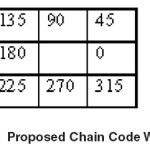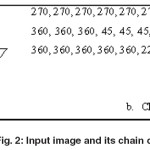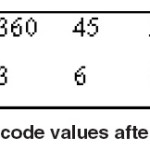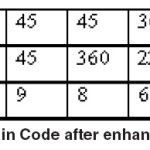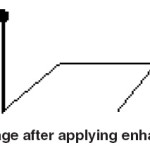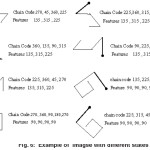Israa Hadi Ali
University of Babylon- College of Information Technology, Iraq.
Article Publishing History
Article Received on :
Article Accepted on :
Article Published :
Article Metrics
ABSTRACT:
In this paper, we have proposed image features based on chain code approach and RLE compression method for enhancing the image and proposed new method for extracting the features. The proposed method consist of the many steps, First is to apply the Chain code algorithm by using new chain code window, Second is to apply the Chain code Enhancement, in this step the chain code is first extracted and then enhanced by applying the RLE compression on the result, the purpose for this operation is to approximate the image by eliminate the small part of image and added it to the largest nearest part and the third is is to extract of chain code features by proposing a new algorithm.
KEYWORDS:
Chin Code; Image features; RLE Compression
Copy the following to cite this article:
Ali I. H. New Method for Image Features Extracting Based on Enhanced Chain Code. Orient. J. Comp. Sci. and Technol;6(4)
|
Copy the following to cite this URL:
Ali I. H. New Method for Image Features Extracting Based on Enhanced Chain Code. Orient. J. Comp. Sci. and Technol;6(4). Available from: http://www.computerscijournal.org/?p=2857
|
Introduction
Image features are useful extractable attributes of images. Examples of image features are the histogram and the symmetry of a region of interest. Histograms are considered a low-level feature, while geometric descriptors as symmetry or orientation of regions of interest provide examples of high-level features.
Some features, such as histograms and texture features, are statistical in nature, while others, such as the Euler number or boundary descriptors of regions, fall in the geometric domain. Geometric features are key in providing structural descriptors of images. Structural descriptions of images are of significant interest. They are an important component of high-level image analysis and may also provide storage-efficient representations of image data.
Typically, high-level image analysis starts with structural descriptions of images, such as a coded representation of an image object or the relationships between objects in an image. The descriptive terms “inside of” and “adjacent to” denote relations between certain objects. Representation and manipulation of these kinds of relations is fundamental to image analysis.
Image representation and extracting the features of image is an important component in image processing and pattern recognition or various applications. One of the methods to represent an image simply and efficiently is by using chain code3.
Debi Prasad B. et al. proposed a new algorithm, based on chain code along with another significant characteristic, number of vertices (end or junction point) and edges (chain code, from one vertex to another) existing in each alphabet has been used to identify English Capital Characters2. Pornchai M. et al. presented a new approach to extracting and representing structural features of images. The approach is based on both a region-based analysis and a contour-based analysis7. A chain code based feature extraction method is investigated for developing Hand Written character Recognition HCR system. 8–neighborhood method has been implemented which allows generation of eight different codes for each character. These codes have been used as features of the character image, which have been later on used for training and testing for Neural Network (NN) and Support Vector Machine (SVM) classifiers1.
Chain Code
An 8-direction Freeman Chain Code is used to represent the frequent number data of the stroke. The Freeman code carries connectivity and geometric information. Skeletal representation of features in the raster image can be expressed by the chain code. This code follows the contour and keeps track of the directions as we go from one start pixel to the next [6]. The chain code provides a storage-efficient representation for the boundary of an image in a Boolean image. The chain code representation incorporates such pertinent information as the length of the boundary of the encoded object, its area, and moments. Additionally, chain codes are invertible in that an image can be reconstructed from its chain code representation4.
The Proposed System
In this paper we proposed a new technique to determine the features of an image in any direction or any size based on chain code and RLE compression5. The proposed method consists of the following steps:-
First: Apply the Chain code algorithm
In order to apply chain code algorithm we suggest new window to represent the transition in the degree as illustrated in figure 1, The chain code algorithm as below.
Chain Code Algorithm
Input: image
Output
Chain Code Vector C
Begin
Find out starting pixel which has nonzero value
Put center of chain code window on starting pixel
While (Not reach to first point ) Or (Not Exist another pixel) Do
Begin
Travels all 8 neighbors and Find first nonzero value
Add the corresponding chain code on chain code vector.
Move to next position
End
End.
Second: Apply the Chain code Enhancement
In this step the chain code is first extracted and then enhanced by applying the RLE compression on the chain code vector. The purpose for this operation is to approximate the image by eliminate the small part of image and added it to largest nearest part, this can do by compare the counter for each code threshold th1 to determine that the part of image which represented by this code small or large, if it small then compare the codes of previous and next parts with threshold th2 as illustrated in the following algorithm.
Algorithm of Chain_Code_Enhancement .
Input: Chain Code in Vector C.
Output: Enhanced Chain Code in ECC vector
Begin
Call Algorithm of RLE Encoding on Vector C .Save the code values in vector CC and the counter values in vector CO
for k=2 to n-1 do
If CO[k]<=th1 AND (CO[k-1]=>th2 OR CO[k+1]=>th2) then
IF CO[K-1] < CO[k+1] then CC[k]=CC[k-1] Else CC[k]=CC[k+1].
Call Algorithm of RLE E on CC to save code values in ECC vector .
End.
For example, we have applied chain code for figure 2.a, and the chain code result is shown in figure 2.b .
After applying RLE we get the code values in vector CC and the counter values for each code in vector CO as shown in Figure 3.
Consider th1=3 and th2=5 then we obtained the new chain code in vector CC and then applying RLE on it to get new vector ECC as shown in Figure 4.
The image which obtain according to above ECC vector is shown in Figure5.
Third: Extracting of chain code features
In this step we extract the features vector of the image based on degree of transition for each part by compare its code with the nearest part code, as illustrated in the following algorithm.
Algorithm of Chain_Code_Features
Input: Enhanced Chain Code Vector ECC of n values.
OutPut: Chain Code Features Vector CCF.
Begin
For i=1 to n-1 do
If ECC[i]< ECC[i+1] then CCF[i]= | ECC[i]-ECC[i+1] |.
Else CCF[i]= | ( 360-ECC[i] ) + ECC(i+1) |.
End
Conclusion
In this paper we proposed new technique to extract the features of the image based on chain code and RLE compression. Based on the experimental results, we can possess the following characteristics: (1) The features can represent the shape of image in any direction or any size . (2) They can use as input data for analysis, classification, clustering and identification systems. (3) These features give a good indicator about the nature of image from geometrical aspect. (4) Based on these feature and the chain code we can reconstruct an enhanced image. (5) We can regard the system as approximated system because it removes the small (insignificant) segments and added to the most significant.
References
- Gunvantsinh G., Rekha T. and Mahesh G.; “ Chain code and holistic features based OCR system for printed devanagari script using ANNNN and SVM”; International Journal of Artificial Intelligence & Applications (IJAIA), 3(1): (2012).
- Debi Prasad B., Susmita K.;”English alphabet recognition using chain code and LCS”; Indian Journal of Computer Science and Engineering (IJCSE), ISSN : 3(2): (2012).
- Ravi S., N. Chauhan, Mahesh M. Goyani, Kinjal A. Mehta; “ Handwritten Character Recognition System using Chain code and Correlation Coefficient”; International Conference on Recent Trends in Information Technology and Computer Science (IRCTITCS), Proceedings published in International Journal of Computer Applications (IJCA) (2011).
- Gerhard X. Ritter, Joseph N. Wilson;” Handbook of Computer Vision Algorithms in Image Algebra”; CRC Press LLC (2001).
- Ida Mengyi P.; “ Fundamental Data Compression”; ELSEVIER (2006).
- Lili Ayu Wulandhari, Habibolah Haron, Ariffin Moahammad, “The Mapping Algorithm of Rectangular Vertex Chain Code from Thinned Binary Image”, University Teknologi, Malasiya (2010).
- Pornchai M., Chakarida N. and Thanee D.; “Represent Image Contents Using Curves and Chain Code “; MVA2007 IAPR Conference on Machine Vision Applications, May 16-18, Tokyo, JAPAN, (2007).

This work is licensed under a Creative Commons Attribution 4.0 International License.
